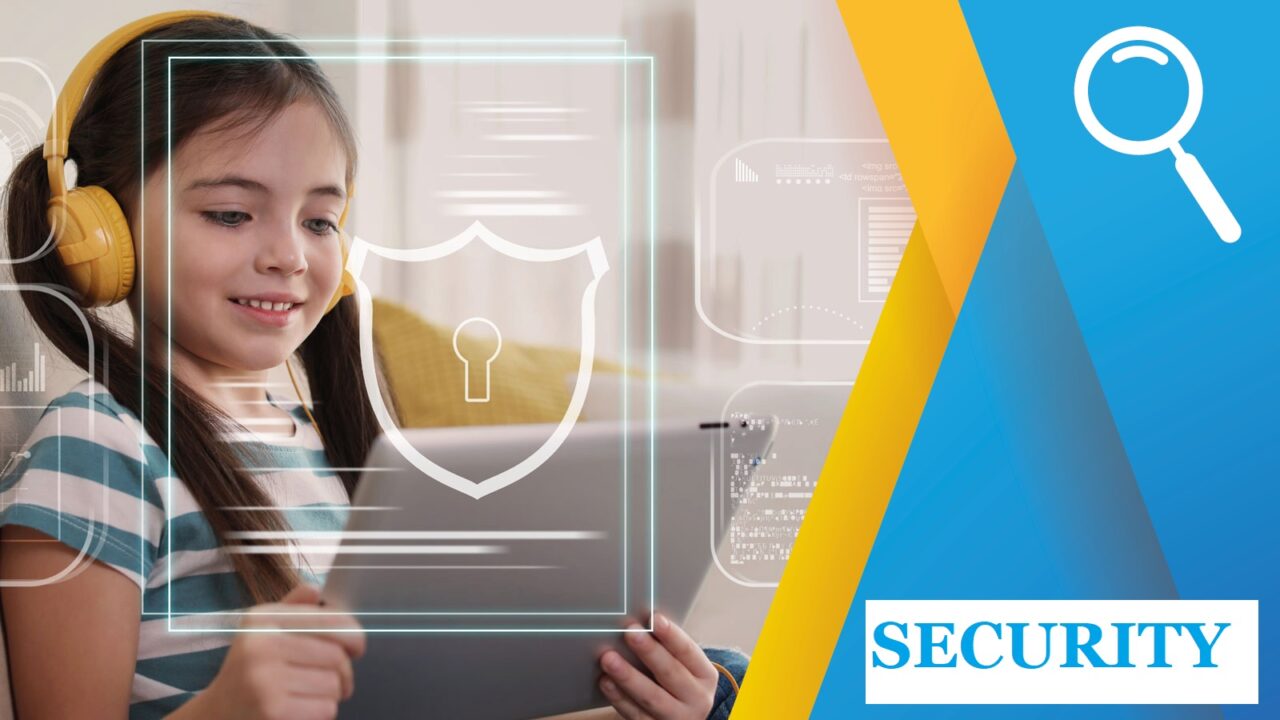
Some important advice on kids’ security online
Mobile phones, computers, apps, and games can contain a lot of information that children should keep safe and private. Fortunately, there are smart ways to protect them from fraud and crime. Here, you can read the facts and advice on this topic.
Choose language in the Google-box below. Some translations may be flawed or inaccurate.
Facts and information
The cell phone or computer of a child is like a diary. Not only is this an item of value in itself but also a key where all installed apps, email services, and other programs are open for use.
Therefore, the child’s device should be “locked” so that unauthorized persons cannot gain access. In addition to physical threats like someone stealing children’s phones, there are criminals operating online. For example, there may be cases where someone gets hold of the children’s username and password, changes it, and then locks the children out of the account they have spent a long time building up. Strong passwords and the use of two-step verification can help prevent this from happening.
Other challenges can be financial if children buy content or click on links to expensive subscription services. Hundreds or even thousands can be deducted from the bank card. You can prevent such unpleasant surprises by having separate child users with purchase barriers and setting up a spending limit on the mobile subscription for the children.
You should also choose good privacy settings to limit the audience on social media and games. Unlimited chats with strangers can lead to unpleasant situations and other types of unwanted communication. And while all the world’s settings aren’t a safeguard against online risk, they can still reduce the scale of challenges.
Last but not least, there are some malware and links that lead to scam sites. Some of these can be avoided by keeping apps and devices up to date, and by raising children’s awareness of avoiding clicking on suspicious links and being critical of the use of public networks.
Some facts about Norwegian children:
Among children between 9 – 18 years:
- Half have open users on TikTok. (In general, 45 – 60% have a private user on social media)
- 7 out of 10 have accepted a friend request from someone they don’t know before
- 29 percent know their parents’ password on Google Play or the App Store
- 24 percent have shared their password on social media with friends
And in addition, 44% of parents do not use parental controls on their kids’ devices.
(Children and Media, 2020/Parents and Media, 2020)
Our advice
Advice for parents:
- Give your children a separate “child user” managed by a parent
- Use screen lock
- Choose secure passwords in social media, games, and other services
- Turn on the two-step verification
- Update devices and apps regularly
- Be aware of using public networks
- Review privacy settings
- Teach kids to take screen evidence
- Report hacking, spam, and cybercrime
Give your children their own “child user”
Whether it’s a computer or mobile phone, you can create child users. Then as a parent, you can set a limit on spending on apps and games, websites the children can visit. You can also limit functions such as camera, GPS location, contact lists, and more.
Thus, the parents become the “safety experts” on behalf of the children. By prohibiting the child from downloading apps and visiting certain websites, you can limit the scope of likely downloading of suspicious apps.
How to set up “child users” on:
iOS: Via Screen Time feature
Android: Via Family-link app
Windows: Via Microsoft family group
Game consoles: Read more on our collection page
- Tip: Does your child have a mobile phone subscription? Make sure it is registered in the child’s name. And then block mobile data, special numbers, content services, and international calls.
Create a screen lock
Locking a mobile phone or computer with a passcode prevents others from logging in and snooping if they physically get hold of the device. Often you are already logged in to various social media and email services that are open when the device is unlocked.
There are different forms of locking the device – it can be done through the use of fingerprint, facial recognition, or a passcode.
To set up a screen lock:
iOS: Settings > Face ID and Passcode
Android: Settings > Security and Location > Screen Lock
Windows: Settings > Login Settings
- Tip: Apple products have a setting that erases all data on the device after ten failed attempts to unlock the screen. This is an extra layer of security so that the “thieves” do not get a chance of endless attempts. Be sure to back up your device regularly so you don’t lose data this way.
- Tip: Choose a code that is hard for others to guess (don’t use birthday, zip code, year, etc.)
- Tip: Set the screen lock to turn on as quickly as possible after use.
- Tip: If the device is stolen, both Google and Apple have features to lock the device remotely or erase data.
- Therefore, turn on “Where is” on Apple products and Android
Use secure passwords
All social media and gaming and email accounts should be secured with good passwords. The most important thing is that the passwords are long and at the same time easy to remember! Parents should talk to children about keeping passwords private. Norsis provides these tips for creating good passwords:
- Create as long passwords as possible
- Have different passwords for each account
- Use numbers, symbols, and uppercase/lowercase letters
- Do not use words or numbers that may be associated with you or the service to which the password applies
Norsis also warns against using the “remember password” feature. Many browsers suggest remembering the password for the next login. However, this is not a safe solution.
“Remember login,” (that the service remembers that you have logged in before) does not pose the same risk as others stealing the password. You can make the password job easier by using programs that remember and create passwords for you.
For example, Apple has a password generator (Keychain) that suggests and enters strong passwords on various services. Google has something of the same with “Smart Lock.”
Norsis says that you can use password management programs as long as these are locked with a double lock (master password).
- Tip: Use a phrase or sentence to create a password that’s easy to remember. For example, “Ilikepizzacolaandtaco28”
- Tip: Some services even tell you if your password is secure enough when registering a new account
- Tip: If you suspect that someone else has accessed your account, change the password
Turn on the two-step verification
Two-step verification should be mandatory across all apps, social media, and games. For every login to a service on a new device, a unique code is required that is sent to your mobile phone or email.
Even if someone gets hold of your child’s username and password, they won’t be able to log in without this unique code. You can usually choose to have the code sent to you by SMS, email, or through an approver app.
- Tip: Two-step verification can also have other titles such as “two-factor authentication,” “multi-factor authentication” or “multi-factor verification.” In any case, the principle is the same.
Learn more about specifically turning on two-step verification in popular apps and games.
Download security updates regularly
Periodically, Apple, Google, and Windows push out system updates to their devices. These include updates that provide better security. As a rule, your computer or mobile phone will sort this out on its own by keeping up to date. However, you can always check in settings and manually check for updates every now and then. It’s also important to keep the apps up to date that your kids use.
On a Windows PC, you should turn on a firewall and virus program. One can use the solution that already exists in Windows. On mobile phones and tablets, this security solution is in some ways built into the device. Although separate antivirus apps can be downloaded as well.
- Tip: Be critical of apps and programs you download. Is the source/website/owner of the app trustworthy? Google and Apple are checking through the apps in their stores, but here too challenges have arisen in the past.
- Tip: Review what permissions apps are requesting. Is it right that the app should be allowed to use GPS, the contact list on the phone, the microphone, etc.? Does that associate with the app’s purpose?
- Tip: Be critical of links that pop up in emails. Scammers can create impersonator pages similar to everything from social media to your online banking.
- Tip: Be critical of links and unusual messages (strange way of addressing) from friends on social media and in games. It may happen that friends have had their accounts hacked and that the scammers send links with viruses/fake logins through their accounts.
Beware of public networks
Connecting to home networks and mobile data differs from public networks in restaurants and shopping malls. In general, you can say that the latter provides poorer security – where unauthorized persons can potentially gain access to the traffic on your mobile phone.
So, if what you are dealing with sensitive data – online banking and the like – you should switch to mobile data and not public networks. If you are even more advanced, you can use VPN solutions, which secure the information from sender to receiver.
- Tip: Some mobile phones offer internet sharing. So, you can “borrow” mobile data from your mobile phone for the child’s tablet or computer.
Choose good privacy settings
Many apps and games have good privacy settings that can affect who can see the content you post and who can contact you. It is always wise to take a look at what options exist to limit this.
- Tip: Make the social media account “private” so that not everyone can see the content the child posts.
- Tip: If possible, limit the possibility of private messages to friends only.
- Tip: Check if your profile is visible to others and don’t enter personal information here like address, real name, school, etc.
- Tip: Be aware of sharing photos. Is it better to choose “friends” and not “public/everyone?”
Take screen evidence
If something criminal has occurred on the internet, it may be a good idea to take a picture of the screen as evidence. For example, chats and photos. This can be done both on a mobile phone and a computer. See the procedure here.
Report hacking, spam, and cybercrime
All major gaming and social media platforms have reporting options.
There are also separate opportunities to report crime and other types of violations. Among other things, you can help prevent the person from deceiving others, for example by reporting and eventually deleting the account.
The content owner may also have logged evidence or other types of information connected to crimes and may be useful for police investigations.
Advice for children
- Use the screen lock that your parents have set up for you.
- Choose secure passwords on social media, games, and other services.
- Don’t share your passwords with others.
- Turn on two-step verification and get help from an adult if you don’t know how to do this.
- Create private social media users if you only want friends to see the content you share.
- Take screen evidence of harassment, bullying, or any other type of criminal behavior.
- Tell parents or an adult you trust if something criminal happens online!
- Take advantage of the reporting capabilities available on social media and games.
- Only use wireless networks that you trust and don’t share private information on public networks.
Resources
For parents:
- Barnevakten’s collection page on smart settings
- For in-app purchases and games/e-commerce/mobile services – Forbrukerrådet
- In case of suspicion or violation of law, contact the police directly. You can also submit general tips.
- In case of unexpected withdrawals from the bank account or concern about account information, you should contact the online bank.
- For expenses related to the mobile subscription, you should contact your mobile operator.
- For photos and content that have been shared without your permission/help to delete accounts – slettmeg.no
- In the case of accounts that have been hacked/lost on social media and games, you should contact the service provider directly.
- Free netiquette course from nettvett.no
For children:
- Barnevakten’s episode on online safety for students
- no – Learn about privacy, netiquette and digital judgement
Research, reports, and links
Here you will find relevant sources and data material that provides insight into topics about children and young people’s safety online.
- The Norwegian Media Authority’s surveys on children and young people’s media habits: Children and Media, 2020
- The Norwegian Media Authority’s surveys on parents’ regulation of their children’s media use: Parents and Media, 2020
- EU Kids Online 2020
- Norsis: Youth and digital security culture, 2017
Photo: New Africa / Shutterstock.com
(Translated from Norwegian by Ratan Samadder)










